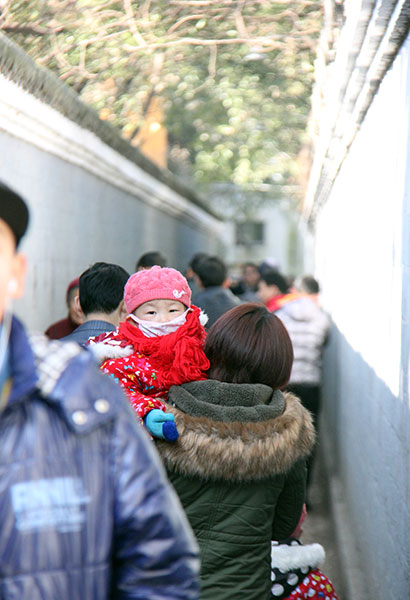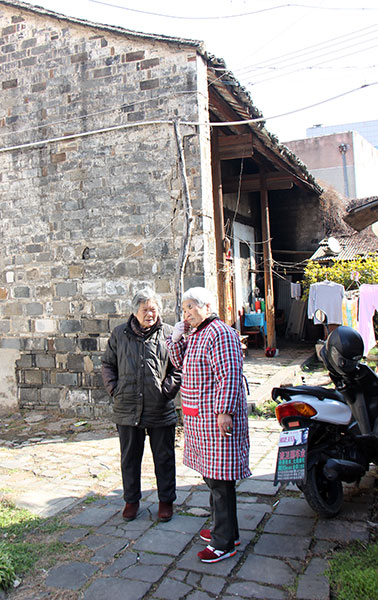Top official's visit and prime spot on New Year TV gala cements popularity and story of historic walkway
 |
|
Visitors flock to Liuchi Lane in Tongcheng city, Anhui province, to admire the historic site. Photos by Zhu Lixin / China Daily
|
In East China's Anhui province there is a 2-meter-wide lane that separates a pair of gray walls.
At first glance it may seem insignificant, but to those who know its history, Liuchi Lane in Tongcheng symbolizes much more than its initial appearance would suggest.
During the weeklong Spring Festival, the lane was filled with thousands of visitors each day - drawn to the 100-meter-long lane by the story behind its creation, and the lessons that can be learned from it.
The name derives from the Mandarin word for six and "chi", a traditional Chinese unit of length that corresponds to one-third of a meter.
It was so named because of its width, and in the early Qing Dynasty (1644-1911) it served as the boundary between the households of two eminent families.
To the south was the Zhang family and to the north the Wus. Both had male members in high positions within Emperor Kangxi's (1654-1722) court, or in other regions around the country, but the two families quarreled.
The source of their dispute was the boundary between their two properties, and which family had the right to build a wall on the dividing line. After trying, and failing, to appeal to a regional official for mediation, the Zhangs wrote to Zhang Ying, their most prominent family member and a trusted top official in the emperor's court.
His response, which is still celebrated to this day in the form of a poem, did not provide the support that his family had hoped for.
Instead, he called for his kinfolk to step back 1 meter from the boundary - a suggestion that so moved the warring parties, the story goes, that both did exactly that and the lane was born.
This legend gained national exposure following a visit by Wang Qishan, China's top graft-buster and head of the ruling Party's Central Commission for Discipline Inspection, on Nov 15, 2014.
 |
|
Two senior residents chat in the courtyard of an old house along the lane. ZHU LIXIN/CHINA DAILY
|
Three days later, the commission released an article on its website that was widely read, referencing the lane amid some thoughts on tolerance, morality, social order and the qualities that define a good official.
Greater publicity was to follow when the legend of Liuchi Lane was highlighted in this year's Spring Festival Gala Show, broadcast by CCTV to an estimated audience of 1.03 billion.
Popular actress and singer Zhao Wei sang a song about the lane, in one of the show's most-watched segments.
"It was the gala show that really increased the lane's popularity", said Zhang Yun, Party chief of the local Shengli community.
He said it was impossible to count the number of visitors who had flocked to the lane over the Spring Festival holiday, but estimated that "at least 5,000 people" had visited each day.
Although the walls that define the lane are replicas, with the originals having been torn down alongside much of the surrounding houses during the "cultural revolution" (1966-76), people are still drawn to the area because of the story behind it, according to Wu Jianqiang, deputy director of the city government's publicity department.
"To ordinary folk, the story is about how to get along with other people, while the authorities think it can also serve as a guideline for officials," Wu said.
Work is under way to restore the area to its original glory, according to Duan Pengfei, chairman of the State-run Tongcheng Culture & Tourism Investment and Development.
"The local government made a plan to restore the original houses in 2011. The detailed plan and design will be finished by the end of 2016," he said.
By Zhu Lixin and Ma Chenguang in Tongcheng, Anhui (China Daily)
Using WeChat? Scan QR Code or Press the Fingerprint Below ↓
--- (Or ADD WeChat ID: OKOKOKOKnet)
